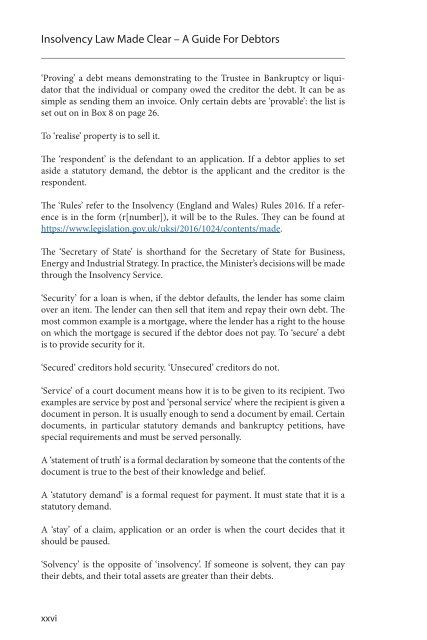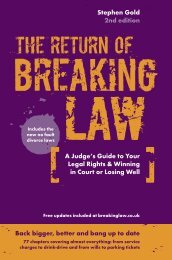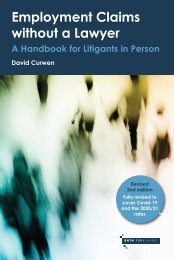Insolvency Made Clear: A Guide for Debtors
Plain English, practical guidance for anyone facing demands over a debt they are struggling to pay.
Plain English, practical guidance for anyone facing demands over a debt they are struggling to pay.
You also want an ePaper? Increase the reach of your titles
YUMPU automatically turns print PDFs into web optimized ePapers that Google loves.
<strong>Insolvency</strong> Law <strong>Made</strong> <strong>Clear</strong> – A <strong>Guide</strong> For <strong>Debtors</strong><br />
‘Proving’ a debt means demonstrating to the Trustee in Bankruptcy or liquidator<br />
that the individual or company owed the creditor the debt. It can be as<br />
simple as sending them an invoice. Only certain debts are ‘provable’: the list is<br />
set out on in Box 8 on page 26.<br />
To ‘realise’ property is to sell it.<br />
The ‘respondent’ is the defendant to an application. If a debtor applies to set<br />
aside a statutory demand, the debtor is the applicant and the creditor is the<br />
respondent.<br />
The ‘Rules’ refer to the <strong>Insolvency</strong> (England and Wales) Rules 2016. If a reference<br />
is in the <strong>for</strong>m (r[number]), it will be to the Rules. They can be found at<br />
https://www.legislation.gov.uk/uksi/2016/1024/contents/made.<br />
The ‘Secretary of State’ is shorthand <strong>for</strong> the Secretary of State <strong>for</strong> Business,<br />
Energy and Industrial Strategy. In practice, the Minister’s decisions will be made<br />
through the <strong>Insolvency</strong> Service.<br />
‘Security’ <strong>for</strong> a loan is when, if the debtor defaults, the lender has some claim<br />
over an item. The lender can then sell that item and repay their own debt. The<br />
most common example is a mortgage, where the lender has a right to the house<br />
on which the mortgage is secured if the debtor does not pay. To ‘secure’ a debt<br />
is to provide security <strong>for</strong> it.<br />
‘Secured’ creditors hold security. ‘Unsecured’ creditors do not.<br />
‘Service’ of a court document means how it is to be given to its recipient. Two<br />
examples are service by post and ‘personal service’ where the recipient is given a<br />
document in person. It is usually enough to send a document by email. Certain<br />
documents, in particular statutory demands and bankruptcy petitions, have<br />
special requirements and must be served personally.<br />
A ‘statement of truth’ is a <strong>for</strong>mal declaration by someone that the contents of the<br />
document is true to the best of their knowledge and belief.<br />
A ‘statutory demand’ is a <strong>for</strong>mal request <strong>for</strong> payment. It must state that it is a<br />
statutory demand.<br />
A ‘stay’ of a claim, application or an order is when the court decides that it<br />
should be paused.<br />
‘Solvency’ is the opposite of ‘insolvency’. If someone is solvent, they can pay<br />
their debts, and their total assets are greater than their debts.<br />
xxvi













